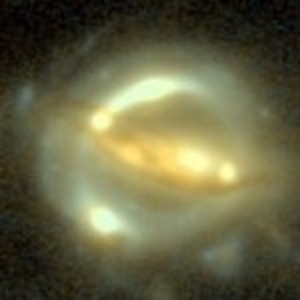Data from the Keck telescope (Mauna Kea), the Hubble Space Telescope and the Very Large Array have been used in conjunction with the findings of the Wilkinson Microwave Anisotropy Probe to offer up a new way to measure the size of the universe, as well as how rapidly it is expanding and how old it is now. By determining a value for the Hubble constant, the work confirms the age of the universe within a span of 170 million years as 13.75 billion years old.
I’m always fascinated with work involving gravitational lensing — just yesterday we looked at using the Sun’s lensing effects for potential SETI investigations — and here we have a classic case of measuring how light traveled from a bright, active galaxy along different paths to reach the Earth. A strong gravitational lens like the one used in this study, called B1608+656, creates multiple images of the same galaxy lying behind the lensing object. Studying the time the light took along each path, it was possible to gather information about the distance of the galaxy as well as the age of the universe and details about its expansion.
Image: When a large nearby object, such as a galaxy, blocks a distant object, such as another galaxy, the light can detour around the blockage. But instead of taking a single path, light can bend around the object in one of two, or four different routes, thus doubling or quadrupling the amount of information scientists receive. As the brightness of the background galaxy nucleus fluctuates, physicists can measure the ebb and flow of light from the four distinct paths, such as in the B1608+656 system imaged above. Credit: Sherry Suyu/Argelander Institut für Astronomie, Bonn.
The lensing effect produced four images of the background galaxy. What’s fascinating about lensing is that the time it takes a light ray to travel a short path can be longer than the time it takes to travel a longer path due to the gravitational time delay caused by the lensing object. This short video with physicist Sherry Suyu (University of Bonn) discusses the effect by analogy with travel times on Earth, and explains how the scientists were able to use the multiple images of the background galaxy to compute the tightened value for the Hubble constant — 21 kilometers per second per million light years. In other words, a galaxy that is a million light years away is moving away from us at about 21 kilometers per second.
An international team is behind this work, which is just out in the Astrophysical Journal. Having made a physical measurement of Hubble’s constant, says Phil Marshall (Stanford University), gravitational lensing “has come of age as a competitive tool in the astrophysicist’s toolkit.” The new value for Hubble’s constant is considered the best estimate of the uncertainty in the constant. Beyond that, however, is the fact that lensing is producing an estimate for the universe’s age that gibes well with other methods of analysis, meaning that we’re learning how to harness this remarkable natural tool for future investigations.
The paper is Suyu et al., “Dissecting the Gravitational Lens B1608+656. II. Precision Measurements of the Hubble Constant, Spatial Curvature, and the Dark Energy Equation of State. Astrophysical Journal 711 (1 March 2010), pp. 201-221 (abstract).




The Planetary Society has a podcast on a study that uses gravitational lensing (stars occulting other stars) to detect planets. If I understand right, in this technique the planet(s) are orbiting the foreground star, which causes a measurable distortion in the lensed image:
http://planetary.org/radio
‘Size of the universe’, I presume, means the size of the *observable* universe, not the entire universe (also including everything beyond our event horizon).
Could such a method, or another, also give us an idea about the size of the *entire* universe, for instance by estimating the curvature? Or is this inherently impossible?
The only size estimates for the entire universe, that I know of, are purely theoretical and lower bounds (such as 10^23 to 10^26 times the observable universe, based on Alan Guth’s inflation theory).
Perhaps the most significant aspect of this finding is that the value this group measured for the Hubble constant agrees so well with other groups who have used methods of measurement based on completely different physics concepts (Cepheid variables, supernovae, etc.). This essentially means that we are zeroing in on the actual value of the Hubble constant after decades of hard work and lingering uncertainty surrounding this fundamental parameter. I agree with those who maintain that we have learned much about the large scale structure and evolution of the Universe, but we still have many mysteries left to solve. Great work my friends!
Concerning the ‘total’ or ‘entire’ universe, and the multiverse, this is just in at Next Big Future (my other favorite website):
http://nextbigfuture.com/2010/03/research-that-considers-multiverse.html
I think, however, that there is some confusion concerning the different concepts: observable universe (unto *our* event horizon), total/entire universe (everything, also beyond our event horizon, stemming from the same original Big Bang, and hence possessing the same physical laws), and the multiverse (different universes originating from as many BB events).
But the confusion may be entirely mine. For a simple provincial boy like me, being mainly interested in the Local Group or maybe the Local Supercluster, all this is quite mind-boggling ;-)